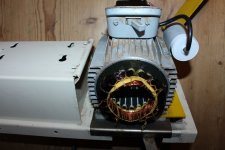r8hil
Plastic
- Joined
- Jan 13, 2023
- Location
- Aylesbury - UK
Hi,
I was hoping some motor experts might be able to help me here. I have a single phase motor off an old Kity Table saw that has recently started to struggle speeding up and I opened it up to find some of the windings burnt. I'm not sure how this happened but it's no longer running effectively and I guess it needs a rewind? Has anyone done this themselves, and if so, how do you varnish the windings?
Thanks
I was hoping some motor experts might be able to help me here. I have a single phase motor off an old Kity Table saw that has recently started to struggle speeding up and I opened it up to find some of the windings burnt. I'm not sure how this happened but it's no longer running effectively and I guess it needs a rewind? Has anyone done this themselves, and if so, how do you varnish the windings?
Thanks





